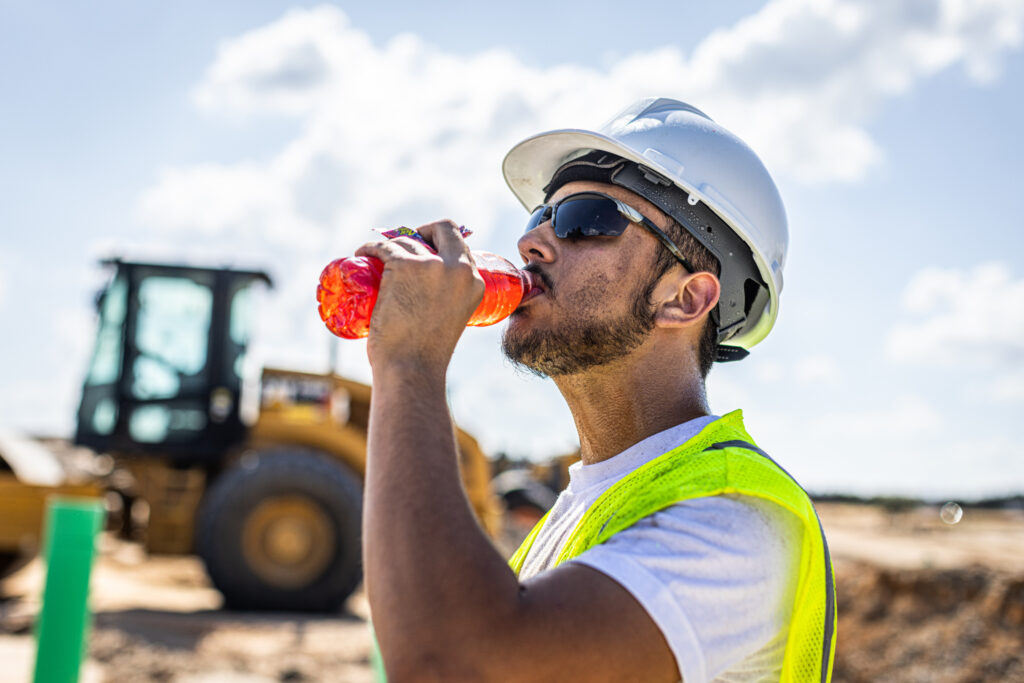M.B. Sutherland, MAGID
ISEA Marketing Committee
According to an article in Forbes Magazine, July 4th this year “was the hottest day on Earth in as many as 125,000 years—breaking a record set the day before.” While many of the highest temperatures are being recorded in notably intense locations like California’s Death Valley, the Washington Post estimates “over 100 million people in 15 states from the western U.S. to South Florida” are under heat alerts. As of this article’s publication date, the nationwide heat dome has traveled north and east to bake midwestern states as well.
These conditions, as well as Thursday’s announcement by the Biden Administration that they will ask the Department of Labor to issue a first-of-its-kind Hazard Alert for heat while increasing enforcement of current heat rules, have prompted lawmakers and safety professionals alike to reevaluate their heat safety measures, including those concerning proper hydration.
Some states have already started the conversation, including a new Washington State rule mandating employers to provide “potable water that is suitable to drink and suitably cool in temperature. Other acceptable beverages include drinking water packaged as a consumer product, and electrolyte-replenishing beverages (i.e., sports drinks) that do not contain high amounts of sugar, caffeine, or both, such as energy drinks.”
All good advice, but it begs the question—what exactly is a sports drink, how does it differ from an energy drink, and is there a “right” mix of water and electrolyte-replenishing beverages? We sat down with executives at Kent Precision Foods Group – Michael Dalton, Brand Manager, Sqwincher Industrial, and Bubba Wolford-Director of Business Development & Training, to discuss the pros and cons of the various options. Dalton explained that electrolyte beverages and energy drinks serve distinct primary functions and have different formulations.
Energy Drink Facts
According to Dalton, energy drinks largely focus on providing a quick energy boost through caffeine, added sugars and other legal stimulants. The CDC advises that, while many of these legal stimulants can increase alertness, attention, and energy, they can also increase blood pressure, heart rate, and breathing. Energy drinks may provide a short-lived burst of energy due to caffeine and other additives, but normally they don’t contribute to long-term physical performance and may lead to issues such as energy crashes, weight gain, and can increase the risk of health complications.
...electrolyte drinks prioritize maintenance of electrolyte balance and replenishment of essential minerals...
Electrolyte-Replacing Beverage and Sports Drink Facts
Dalton explained that electrolyte drinks prioritize maintenance of electrolyte balance and replenishment of essential minerals such as sodium and potassium, which play vital roles in various bodily functions. Electrolyte drinks can help prevent dehydration, muscle cramps, and fatigue by ensuring proper fluid balance and electrolyte levels in situations that involve excessive sweating (electrolyte loss), such as working in temperatures of 80 degrees Fahrenheit or higher for prolonged periods.
Many sports drinks also provide electrolyte and mineral replacement, but it’s important to read the label! You may find that the beneficial ingredients in some drinks come with a whopping dose of sugar that rivals an equal amount of soda—and that can bring workers right back to the negative effects of energy drinks.
Keep in mind, of course, that sugar isn’t bad in every circumstance. While regularly consuming beverages with a high sugar content is clearly a bad idea, having some electrolyte-replacing beverages that do contain sugar on hand can save the day in some emergencies. Wolford related the story of a diabetic firefighter who was recently overcome by the heat while fighting a house fire on a 90+ degree day. The man’s blood sugar was crashing as he suffered from heat illness. A non-sugar-free electrolyte-replacing beverage put him back on track. “He perked right up!” the customer raved.
... studies may point to a mix of water and electrolyte replacement as the best option.
Is Plain Water Enough?
The many options and information out there may tempt you to go back to tried and true cool water to keep your workers safe. But studies may point to a mix of water and electrolyte replacement as the best option. A recent Washington Post article featured the work of Roxana Chicas, a nurse-researcher at Emory University studying farmworker health in hot weather. Chicas’ research was in part spurred by the mysterious prevalence of kidney failure in farmworkers in Central America. Chicas began collecting blood and urine samples from 119 farmworkers in Florida over a period of 32 months. Her results, which have not yet been officially published, showed that 33 percent of the workers showed kidney injury, which became more common with a higher heat index. As the study continued over time, Chicas discovered that workers who drank electrolyte-replacing beverages showed no kidney injury at all, while 23 percent of workers who drank plain water had kidney damage.
But before you decide to go all-out, drinking nothing but electrolyte-replacing beverages, remember that it is possible to have too much of a good thing. The Cleveland Clinic warns that too much of some electrolyte elements in your system can lead to adverse symptoms ranging from headaches and fatigue to breathing difficulty and heart arrhythmia.
The Best Advice?
As with most things, the best advice is to know your own body and circumstance. For individuals, that means talking to your doctor about any medical conditions you may have that might warrant increasing or moderating electrolyte intake. For safety professionals, offer a variety of both water and low calorie, low sugar electrolyte beverages for your employees, while keeping some electrolyte beverages that contain sugar available for those who may need them in an emergency – but stay away from the instant jolt of sugar and caffeine filled drinks. And speaking of moderation, you’re unlikely to go wrong as a safety professional or as an individual in choosing a healthy mix of both electrolyte replacement beverages and good old-fashioned cool water.


